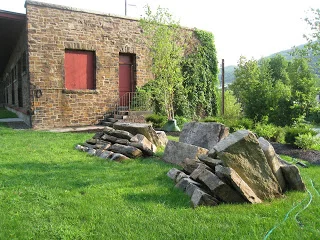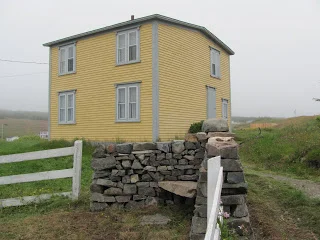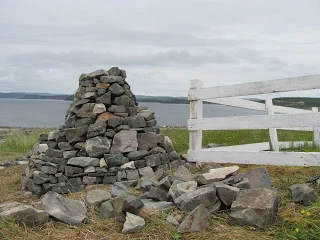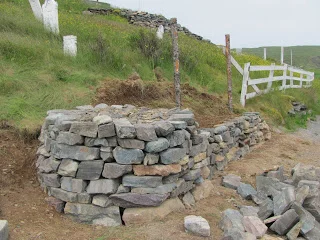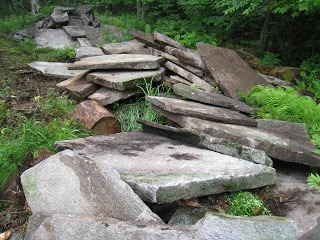The previous post elicited a question from a reader about the dry stone cairn in the top photo. It’s a trail marker, one of hundreds found alongside the old routes in Norway for crossing the high country from one valley community to another. They are spaced approximately 50 meters apart to help guide those traveling in fog, snow or low light conditions. The pine poles atop them may be all that’s visible in a sea of winter white.
Read MoreFrom the glacier fed streams of Norway’s Jotunheimen mountains, I’ve traveled this past week to the low, wetlands of Denmark. In fact, I’m living in a 300 year-old house alongside a castle moat. This is the artist’s residence for TICKON, the environmental art park I’ll be working in for the next month. Yesterday 20 tons of stone was gathered from field piles and delivered by the tractor-wagon load to the site of my construction. Today the outline of the work will be established and guide frames erected.
Read MoreContinuing on the subject of sculpture gardens, here’s a nice example I saw yesterday outside the Art Museum in Lillehammer, Norway. Created in 1992 by Bard Breivik, the sculptured garden is a cascade of stone and water. It begins serenely on flat ground at the height of the space. There, a screen of vertical granite slabs encloses a dry courtyard, a green lawn is bisected by a flagstone path, and the water course begins by spilling from a granite monolith into a long, stone trough. The water descends in multiple streams through a series of channels to a reflecting pool at the bottom of a steep rockery. Breivik’s sculptured garden is a good example of art that interprets nature without imitating it.
Read MoreDuring my working life I’ve shifted freely, back and forth, from artist to dry stone waller. Whatever the final outcome of any work, it’s been the making that I’ve liked the best. With ‘Rock Rest’, I enjoyed the creative process so much that I built the piece twice; once in my Dummerston stone yard and once here beside the museum. The stone was initially collected from a steep slope on a wooded property in Townshend. It lay there for twelve thousand years after being plucked from the ledges by the last ice age. In ‘Rock Rest’ I’ve attempted to simulate the natural process that turns bedrock into loose stone. I’ve always been fascinated by the way stones separate from one another but lock more tightly together as they slide apart.
Read MoreWhile driving through Sweden on the way to Norway I saw this pair of stone sculptures along-side the canal in Uddevalla. The chair, and “room”, are assembled from carved and broken slabs that are bolted together by threaded rods. I think the combination of natural forms and carved, polished surfaces on the same stone is very effective. Artist unknown.
Read MoreMy thanks go out to all those who made the stone workshops a success. Community members collected stone by the snowmobile trailer load, or by filling up the back of their Subaru. Members of the Centre’s board of directors promoted the workshop, participated in it and brought baked goods and coffee to fuel progress. For those who dug sod, barrowed stone, nailed together guide frames and crafted the works I’m forever grateful for your toil and alacrity.
Read MoreThe dry stone workshops at English Harbour have been treated to buffeting winds, lightning storms, muffling fog and dazzling sunshine over these past two weeks. Participants have gone from working in tee shirts to suiting up in insulated rain-gear. Whatever the weather conditions of the day (or hour) it’s been exhilarating working on the Newfoundland coast. The wide vistas of boreal forestland and ever-changing seascape have made a dramatic backdrop to our dry stone activities.
Read MoreLast night the sky over the harbor was totally star-twinkled. From the bay, which was uncharacteristically placid, came the "whooshing" sound of whales' breaths. The huge animals rhythmically rose to the water's surface in the darkness, exhaling plumes of sea mist. They were invisible to the eye but must have been very close to shore. The 'squeaks' and 'squawks' of their aquatic songs reverberated around the bay. The sonic echoes were hauntingly beautiful but their meaning lost on my land-locked ears.
Read MoreWhile other parts of Canada are experiencing record high temperatures, here on the east coast of Newfoundland we go about in wool sweaters and windbreakers. Lightning storms have made quick visits overhead in the nighttime. Strong winds blow intermittently through the day. But always, in the past week, there has been fog. Time stands still when the quality of light remains the same from dawn to dusk. It’s the color of pewter tinged with green from the landscape of meadow grass and spruce forest. And always the mournful moan of the foghorn in the background calling out from the coastal headlands; a sound I don’t so much hear, as feel in my body like the rise and fall of a breath.
Read MoreSince my arrival in English Harbour under clear blue skies three days ago, the fog has crept in and kept our dry stone walling workshop blanketed in degrees of gray. However, the enthusiasm of all six participants has been nothing less than rainbow bright. They started out on Monday brainstorming their way to a design and plan of attack to begin building the first of four corner features for a new fence around the arts centre. On Tuesday they completed a six-sided base for a stone lantern and a short length of retaining wall. Today we’ll keep a watch out for whales. Maybe the three humpbacks that were feeding on capelin in the harbor on Monday will be back.
Read MoreHaving the fresh supply of stone at my disposal, from last week’s harvesting, has been like getting a blood transfusion for the imagination. I can design with select pieces in mind. I knew when I saw the 6’x7’ slab in the jumble of stone that came off the hillside in Townshend that it was destined for this project in Dummerston.
Read MoreLast week’s stone gathering was harsh work in a tranquil setting. The side-hill that I harvest loose stone from is a mile into the woods up a steep trail. Until the Clark’s and I invaded the scene with loading and transport equipment it was peaceful wilderness. A working landscape, by definition, must tolerate periodic disruptions. The stone I collect from the property will keep me supplied in dry stone construction materials for two years, building things like the barbecue table I made for my friends Peter and Phyllis. Saturday evening’s cookout at their place was as delicious as the sky was dramatic.
Read MoreOften the fatigue that sets into a stone wall over time is caused by natural conditions. This weekend I noticed a piece of wall in Eastern Massachusetts that had been disrupted by the growth of a beech tree. The decorative border wall in the yard of an old farm house was completely subsumed by the ancient monarch. The age of the tree, well over 100 years, suggested that the wall is of an even greater age. To each side of the tree the wall has stood the test of time, remaining in good condition. The tree can be forgiven for displacing the stones, it has the right of long residence.
Read MoreThanks to Sunny Wieler from Ireland for the mention of Sky Watch on his recent stargazing in the garden article - and for telling me about these beautifully hand crafted garden telescopes - also from Vermont.
Read MoreThe road to a project’s completion is often a long and winding one. That’s why it’s worth taking time along the way to enjoy the view. The installation I’ll be doing at TICKON in Denmark later this summer began last year with an invitation from the art park to submit a proposal. Over the months, conversations and emails have taken the proposal through a series of development where I now feel that all the parts are in place to begin the work.
Read More5,000 years ago, in the land that is now Denmark, the dead were entombed in boulder chambers. Dolmens, as they are known to archaeologists, were once covered with earth mounds. Exposed by erosion and excavation, many are now visible on the landscape. I’m intrigued by these constructions. A three-boulder base supports a one-boulder roof. The simplest of forms proves to be the strongest and most durable. Dolmens, like the ones at Lindeskov, were reused over many centuries.
Read MoreEarlier this week I was interviewed on Vermont Public Radio as part of a series on Vermont artists. Here is a link to a podcast of the interview. And here is the link to the interview in the VPR archives.
Read MoreSometimes a single stone is just too big to lift with available equipment. A simple solution is to turn it into two. A rotary hammer armed with a masonry bit will drill six, ⅝” holes in less than ten minutes. Wedge and shim sets are tapped into the holes until a seam opens and the stone pops apart.
Read More


